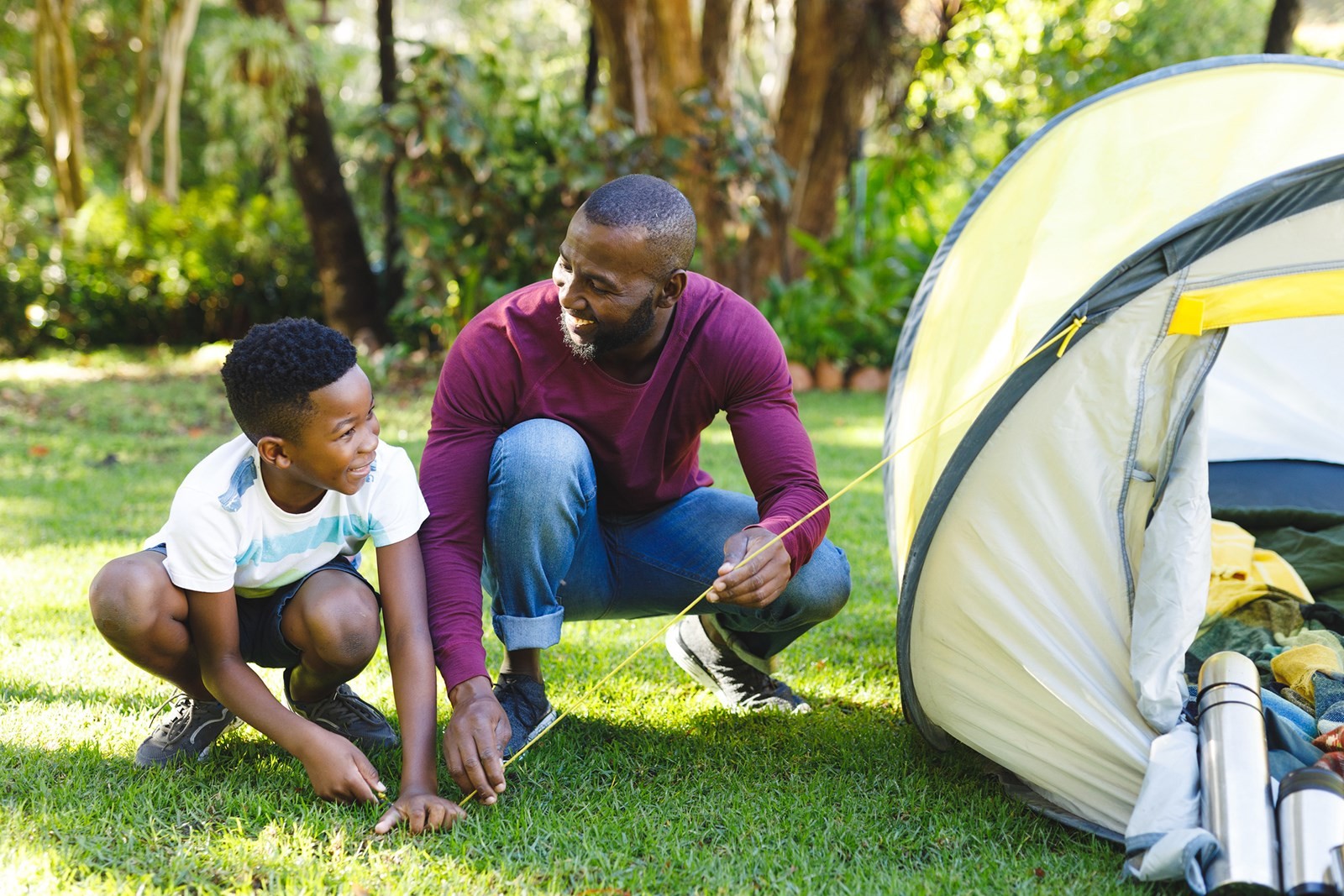Camping offers a fantastic escape from the everyday, and with some thoughtful preparation, you can confidently manage your outdoor adventure. Whether you’re seeking relaxation or an exciting family outing, the wilderness has something for everyone. If you’re asking “how to start camping?”, this guide is for you.
For newcomers to camping, the best approach is hands-on experience. Expect a few minor setbacks, remembering that camping trips rarely unfold exactly as planned. Familiarize yourself with the fundamentals of camping, and cherish the experiences that will hone your skills and build lasting memories.
Prepare for your initial excursion with these helpful camping tips for beginners, setting you up for a successful and enjoyable time outdoors.
Getting Started with Camping
A reliable camping shelter should be easy to set up and provide protection from the elements, keeping you dry, warm, and secure. Comfortable and safe camping depends on your choice of accommodation: a tent or an alternative lodging option. Tents are a popular and accessible choice for beginners due to their portability and adaptability.
Tents are available in various shapes and sizes, offering different levels of weather protection and insulation. Some are designed for solo travelers, while others feature multiple rooms for family use. Before selecting a tent for your first camping trip, consider these factors:
- Your Needs: While tents are beginner-friendly for most, they may not suit everyone. Older adults or individuals who find sleeping on the ground difficult might prefer more comfortable alternatives. Certain tents may also not be ideal for small children or energetic pets.
- Weather Conditions: Tents lack air conditioning and heating. For camping in hot weather, you can set up your tent in a shaded area or bring a battery-powered fan. However, some may choose to avoid tent camping altogether during extreme heat. Similarly, frigid temperatures can be a deterrent. Although tent heaters are available, they require strict adherence to safety guidelines and may not be suitable for all environments.
- Your Experience Level: If you’re unsure about how to get started with camping, learning how to pitch a tent and create your own campsite is an excellent first step. That being said, some tents can be more complicated than others and may require assistance or prior training. Always consult your tent’s user manual and watch instructional videos before embarking on your trip.
Essential Tips for Pitching a Tent
The assembly of your tent depends on the type of tent you have, where you’re setting it up, and any add-ons or accessories you’re using.
Here are some helpful tips for beginner campers setting up their tents:
- Know Your Tent: To properly assemble your tent, you must know what kind of unit you own. Common tents include dome, A-frame, popup, and ridge tents, although other variations exist. Consult your tent’s owner’s manual for specific instructions.
- Choose a Level Spot: The location where you pitch your tent should be on flat ground, ideally in a shaded area, and away from fire pits, mud, rocks, or tree roots. Avoid areas where rainwater might gather and seep inside.
- Be Careful with Tent Stakes: If you are using stakes to secure your tent or tarp, bring extra if possible. Make sure to drive the stakes deep into the ground, and always exercise caution when walking near them, as they can be tripping hazards.
- Always Use a Tarp: Even when the forecast doesn’t predict rain, it’s wise to be prepared for unexpected drizzles. A tarp helps insulate your tent from the elements. It’s also beneficial for summer camping, preventing your tent from overheating.
- Enhance Comfort: To make your tent more comfortable, consider choosing a unit with windows for airflow and natural light. Bring a battery-operated fan or a tent-safe heater to create your ideal sleeping environment. If possible, sleep off the ground by using a cot, inflatable mattress, or sleeping pad. This will keep you warmer, drier, and less prone to muscle soreness. When shopping, look for water-resistant tents, and hang a tarp over the tent roof for added rain protection.
Tent Camping vs. Other Lodging Options
How does tent camping compare to other lodging choices? Both tents and lodging offer unique advantages. Here’s what you need to know:
Always practice good camping etiquette. If camping near others, keep the volume down at night and early in the morning, and never shine flashlights into other campsites. Practice Leave No Trace principles by cleaning up after yourself and leaving your campsite in better condition than you found it.
Choosing the Right Location for Your First Camping Adventure
One of the most crucial camping tips for beginners is selecting the right location. As someone still learning the basics, it’s a good idea to camp somewhere like KOA, where you’re never far from clean restrooms and laundry facilities.
Always consider the following when choosing a camping location:
- Your Camping Goals: Ask yourself why you’re planning this camping trip. Is it to explore new places or visit historical sites? To immerse yourself in nature, or to spend quality time with loved ones around the campfire? Your camping objectives will help you choose the best location.
- Seasonal Considerations: Choose a location that suits the season, considering potential rainfall, temperatures, and which sites offer the most scenic seasonal views, as well as your comfort level with different climates.
- Campsite Accessibility: If you are traveling with young children, some camping locations, such as those that require backpacking or mountain treks, may be too challenging for beginners. Choose a location that is accessible to each member of your group.
Before reserving your stay at a campsite, decide whether you want your journey to take you far from home, or if you prefer to stay closer to home.
Benefits of Staying Close to Home
Many people appreciate the easy commute and reduced planning that comes with closer-to-home trips.
Advantages of camping near home include:
- You may be able to return home for forgotten essentials, like cooking tools or a sleeping bag.
- Shorter travel distances are ideal for easy, beginner-friendly trips.
- Local trips require less planning and travel arrangements, allowing for scheduling flexibility.
- You have the chance to explore your local area and discover new favorite destinations.
- In emergencies, assistance from someone you know is more likely.
Benefits of Exploring a New Place
The primary benefit of camping far from home is experiencing new places. Popular destinations include state and national parks or forests, tourist hotspots, cities with thriving cultural scenes, and family-friendly festivals.
Additional benefits of exploring faraway places on your camping trip include:
- New places offer new experiences, including different cultural attractions, regional foods, and wildlife.
- Long road trips or flights provide unique views along the way.
- You can meet new people from different regions.
- Traveling farther allows you to easily justify an extended vacation.
- If you are considering moving to a new city or state, exploring the local scenery is a great way to decide if it’s the right fit for you.
- With numerous locations, you can count on finding a suitable location wherever you choose to travel.
Camping Essentials for Beginners
A successful camping trip begins with knowing what to bring and how to use those items. A printable packing list of first-time camping essentials is a great way to keep your belongings organized and ensure you haven’t forgotten anything important.
What to Pack
Some essential camping gear for beginners includes:
Sleeping Gear
Bring everything you need for a good night’s sleep, including quilts, sleeping bags, sleeping pads, blankets, an inflatable mattress, or a cot. As your body will be adjusting to new sleeping arrangements, now isn’t the time to try out new pillows. Bring your favorites from home to help your body adjust. Some new campers also find eye masks or white noise machines helpful for falling asleep more quickly.
The appropriate type of sleeping bag depends on wet or dry weather and the maximum low temperature. Thin sleeping bags are generally only good for summer conditions, while others are designed for various levels of frigid temperatures. If you’re staying out in the ice and snow, you definitely want to have the right kind of sleeping bag, so check the labels before you buy them. For winter camping, it’s also a good idea to bring more blankets than you might need.
Campsite Needs
Headlamps, flashlights, lanterns, and outdoor lighting like torches or LED tube lights will keep your campsite well-lit. You will also need a few bundles of approved firewood, a cooler and ice, a water dispenser, and matches, a lighter, and fire starter.
For your belongings that require batteries, bring some extras in case your lamp or flashlight stops working. A portable charger or power bank for your phone or other devices is also good to have on hand. If reception is going to be poor in your area, you might also want to invest in a Wi-Fi extender or similar device to stay connected.
Furniture and Decorations
Add style and comfort to your campsite with camping chairs, plastic tablecloths and tablecloth clips for the picnic table, insect-repellant candles, small tables, shade structures, and portable rain pavilions. An outdoor rug will help catch dirt and grass before you go inside your tent, RV, or cabin.
Necessary Items
Bring hygiene items and toiletries, including towels, washcloths, soap, shampoo, shower shoes, your toothbrush and toothpaste, and your contact lens case and solution, if applicable. You might also enjoy the comfort of a soft robe and slippers.
Cleaning Supplies
Don’t forget to clean up your campsite after each meal and before you leave. Bring trash bags, paper towels, a cleaning sponge, and wipes, if necessary.
Personal Belongings
Personal belongings include your wallet, spare cash, keys, lip balm, and any licenses or permits you need to camp or hike. You should also pack event tickets or parking passes you plan to use during your stay.
Safety Equipment
Stay safe with insect repellant, a water bottle, sunscreen, first-aid kit, and portable fire extinguisher. A local field guide may also be useful if you plan to explore a new area.
Kitchen Supplies
Bring kitchen essentials like pans, tongs, spatulas, a grill grate for cooking over the fire if desired, roasting forks, a coffee percolator, dishes, and utensils. Make sure all pots and pans you bring are rated for campground use and can withstand cooking over an open flame or however you plan to prepare your meals.
Pet or Children’s Supplies
If you are camping with your pet or child, you will also need to bring their items. For pets, this means a leash and harness, food and water bowls, toys, a pet first-aid kit, ID tags, bedding, and vaccination records. For children, you might need a stroller, portable crib or play area depending on their age, toys, special first-aid supplies, and child-friendly food.
What to Wear
Much of your clothing decisions depend on where you are going, the season and weather conditions, and what activities you plan to participate in:
- Rain gear, including boots, a water-resistant coat, and umbrella.
- Light layering pieces, including long-sleeve shirts, lightweight tops, underclothes, and jackets.
- Extra socks and underwear.
- A swimsuit or swim trunks with sandals or flip flops.
- A sunhat, visor, or beanie, weather depending.
- Shoes for all activities, including hiking boots and comfortable walking sneakers for sightseeing and tours.
- Winter clothing, if applicable, including thermal layers, gloves, a scarf, an insulated coat, thick socks, and long pants.
Meal Planning for Camping
The easiest way to save time and make camp cooking a breeze is to plan your meals before you go. This will help you stick to a budget and prepare items ahead of time. As you meal plan, consider on-site dining options or local restaurants you want to try while you are out exploring.
Camp Cooking Must-Haves
Regardless of which recipes you choose to cook, there are some camp cooking must-haves that all campers should have on-hand:
- Cooking essentials: Pantry staples like seasoning blends, spices, dried herbs, cooking oils, salt and pepper, condiments, and sauces will give your food flavor. Choose your essentials based on your meal plan. For example, if you plan to barbecue or grill meats, you may want to bring along barbecue rubs or sauce.
- Snack items: Choose non-perishable snacks that travel well, like kettle corn or popcorn, jerky, trail mix, chips, pretzels, cereal, granola, or s’mores ingredients.
- Meal staples: Proteins, starches, and carbs will help keep you full and energized. Popular camping meals usually involve potatoes, eggs, grilling meats, breakfast meats, fresh produce, sandwiches, canned beans and soups, and bottled water, juice, and soft drinks.
Tips for Planning Your Meals
For easy meal planning, use these tips:
- Consider dietary preferences: If you are camping with a group, consider everyone’s individual preferences and include vegetarian, pescatarian, vegan, dairy-free, or gluten-free options if necessary.
- Prep before you go: To save space and time at the campsite, prep what you can at home. Cut, core, and de-seed fresh produce and mix up some omelet ingredients for an easy pour-and-cook breakfast.
- Use storage containers: Plastic food storage containers and zip bags are great for storing pre-prepped meals and keeping them secure inside your cooler.
- Choose multi-use ingredients: Choose recipes that utilize similar ingredients—like potatoes, a specific sauce, or fresh veggies—to keep preparation simple and take up less space in your cooler or food storage container.
- Include extras and snacks: You will likely be more active than usual, especially if you engage in any outdoor recreation. Plan for high-energy snacks and extra meals to keep you energized. Find meal inspiration on the KOA camping recipe database, where you will find ideas for cooks of all experience levels and dietary preferences.
Essential Camping Tips for First-Timers
With a bit of preparation, your initial camping experience is sure to be memorable and fun. Use these tips to help you make the most of it.
1. Test New Gear at Home
Whether you are a beginner or an experienced camper, you should always test new gear at home first. Assemble your tent in your yard for practice and to make sure everything is included and works correctly. The practice will also make it easier to assemble when you get to the campsite.
Make sure your sleeping bag is comfortable and that all flashlights, headlamps, and lanterns work, too. Pack extra batteries, just in case. If you plan to use a portable cooking stove or grill, give it a test run. Also, ensure all hiking backpacks or day packs fit securely on your back and make adjustments if necessary.
2. Celebrate a Milestone Event
Camping is the perfect way to spend any vacation or weekend trip, but it is also a memorable way to celebrate milestone events, such as:
- Birthday parties.
- Anniversaries and romantic getaways.
- Bachelor and bachelorette parties.
- Bridal and baby showers.
- Family or friend reunions.
Check with your campground to learn more about group lodging options, policies, and on-site facilities.
3. Bring Games and Recreational Gear
Do not leave behind the gear and equipment you need to participate in outdoor or indoor fun. If it is your first time camping, finding the right recreational activities for you will likely take some experimentation. Stay somewhere that lets you try as many new things as possible.
Many campers enjoy the following outdoor activities:
- Hiking
- Fishing
- Sightseeing
- Biking
- Bird watching
- Canoeing, kayaking, and boating
- Backpacking
- Trail running
- Watersports
- Horseback riding
- Rock climbing
Have fun at your campsite with lawn games, including ladder ball, cornhole, horseshoes, croquet, and yard bowling. You should also pack rainy day activities, like cards, board games, and books.
4. Check Campground Guidelines
Always follow all campground rules and guidelines, which are in place for your safety, as well as that of others. Most campgrounds have standards for things like:
- On-site parking and number of vehicles.
- Unregistered visitors.
- Pet type and behavior.
- Excessive noise during quiet hours.
- Keep your campsite and all public areas clean.
Staff members are happy to provide a list of applicable rules to follow, or you can call the campground before placing a reservation to confirm the necessary details.
5. Try New Things and Learn New Skills
As you research how to start camping and assemble your packing list and local guidebooks, it can be easy to over-plan or try to schedule each activity. Camping is best enjoyed when you leave some of it up to adventure and spontaneity. While it is essential to have the gear you need to stay safe and comfortable, lean into those moments that present themselves to you, like an unexpected hiking path, sharing a meal with new friends, or learning a new skill or hobby while traveling.
KOA Can Make Your Camping Trip a Success
KOA is here to help your first camping trip be as fun and rewarding as possible, with helpful staff ready to answer your questions and guide you through the process. You may also have access to some on-site amenities, like playgrounds, games, and special events. Many features vary between KOA locations. Confirm campground details before placing your reservation.
Find a KOA Campground near you to start planning your camping trip today!


